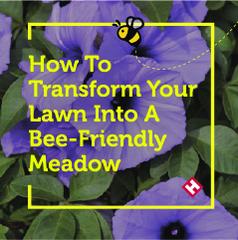
Love bees? Ready to turn an area of coarse grass or that unloved, labour-intensive lawn of yours into a bee-friendly wildflower meadow? Read on to find out how!
Why Meadows are Worth Cultivating
But before we get into the how-to steps, let’s talk about why it’s worth doing in the first place. You will be taking a great big step towards sustainable gardening on so many levels and here’s why:
1. Do it to help save the bees & encourage insect biodiversity, pollination and attract pretty butterflies into your garden. It is an opportunity to create a sustainable habitat with natural landscaping in your own garden.
2. Stand out from the norm. Bring added colour to your property and neighbourhood with an informal and yet romantic rewilding of your space.
3. Did you know flower meadows and pastures also reduce water consumption and flooding by retaining more water?
4. What’s more, there’ll be less lawn maintenance work in the long run! You will be free of the constant mowing, irrigating, sprinkling, weeding that comes with lawn turf. Save yourself the cost of lawn care. Stowaway that dastardly lawn-mower. Use fewer chemicals, lawn products & artificial pesticides.
5. If your lawn is already halfway to being covered in wildflower through neglect or lack of time why not go the rest of the way and make something special
6. It’s a great eco-friendly source of naturally cut, colourful flowers for your home
Where To Start Your Meadow

How big should your lawn to meadow conversion be?
You don’t have to start re-landscaping the whole garden. Try converting a small sub-section of lawn, or the peripheries of your front garden and backyard.
A huge lawn or property isn’t necessary because mini-meadows growing in a postage-stamp-sized space can be just as beautiful.
Imagine how delightful this will look in a patch of urban garden or a shared communal urban square!
Just make sure it’s a sunny open space or corner that will give you the best growth and colour when your flowers appear.
What kind of soil will your meadow need?
Did you know wildflower meadows generally require nutrient-poor soil? This prevents the unwanted growth of vigorous grasses. So no fertiliser needed.
It helps if the location has moisture-retentive soil and has good drainage.
When To Change From Lawn To Meadow
You should start preparing the ground from early spring in March and April.
If you’re now looking at your well-established garden in the height of summer, this would still make for a great transition project when everything dies down naturally. You can also do it in late autumn in September.

It begins with soil preparation
Remove existing weeds first. Spray the ground prior to sowing with a non-chemical weed killer or remove weeds by hand.
Alternatively use the stale-seed bed process - allow weed seeds hidden in the soil to germinate so you can spot them before hoeing them away manually.
Remove the topsoil if it is too rich or fertilized with manure.
How to start planting your new wildflower meadow
Once the ground is free of weeds and vegetation, dig or rotovate the soil, then make the soil firm and start raking in to make a seedbed.
When sowing, rake or roll in your seeds lightly, to give good contact between the seed and the soil. Water the rows, and leave them to grow.
What to sow in your lawn to meadow conversion
This is your chance to create a tapestry of flowers to suit your region throughout the seasons.
It may take some research when it comes to sourcing the right wildflower seeds depending on where you are located.
Consider seeds based on whether you prefer an annual meadow that provides a one-off show (needs richer soil) or a perennial meadow that regenerates seasonally from year to year (you’ll have to remove topsoil that’s too rich).
Allow selected wild species of flowers to establish and thrive if you spot them occurring naturally.
Sow and raise from seed a selection of wildflowers and grasses that can be sourced from seed merchants to your taste.
Be sure to use seeds and varieties that suit your climate and are indigenous to your area. Avoid non-native seeds as this could be detrimental if they take over the countryside or are close to environmentally sensitive areas.
Drop-in all those seed bombs available these days!
If you’re focused on saving the bees and need to know what bees like to eat, take a look at the plants you can sow in our other blog How To Attract Bees To Your Garden
How To Maintain Your New Lawn Meadow

Don't forget high soil fertility encourages the growth of vigorous grasses that will outgrow your lovely wildflowers, so don’t add rich manure or fertiliser.
Keep watering in dry spells until germination begins again with the new season and hand weeding is occasionally necessary to remove obvious aggressive weeds you don’t like.
Don't forget high soil fertility encourages the growth of vigorous grasses that will outgrow your lovely wildflowers, so don’t add rich manure or fertiliser.
Keep watering in dry spells until germination begins again with the new season and hand weeding is occasionally necessary to remove obvious aggressive weeds you don’t like.
Mowing and cutting down your wildflower meadow
In the first year, you could mow more regularly to weaken any grass growth that may happen. Even if you need to mow it down regularly - you will only need half the mowing of a regular lawn.
You may want to regularly dead-head the flower heads to keep them flowering much longer than naturally.
Don’t be afraid of some weeds which can really be wildflowers: like daisies, clover, bird's foot trefoil, buttercups, dandelions, etc- Remember the bees!
You will not have to cut down your meadow until late June or July, just like a traditional farm meadow.
Prepare Your New Lawn Meadow For The Next Cycle
Give yourself a handful of years to get the balance between grass and wildflowers to be established. You may continue to sow new seeds and add more varieties in the first few years until your local ecosystem develops & the wildflower seed bank increases in the soil.
It is important to keep soil nutrients low by cutting back your wildflowers and grasses once a year. You should do this in late June just before the grasses go to seed.
Ready To Be A Meadow Gardener? Here’s What You’ll Need:
Shopping list
Assorted wildflower seeds
Gardening gloves
A rake for the wees
A hoe for sowing
Topsoil for sowing
A trowel or small spade for digging out bulbs and rocks
Horticultural grit for the fallow season to stop weeds
A watering can or hose depending on the size of your meadow
Weedkiller ideally
Large shears for removing larger plants that have gone to seed at the end of the season
Small shears or garden clippers harvesting those lovely flowers for your home during summer
Insect or bee hotels to encourage local bees
Stop by our lawn and garden section to catch an overview of the supplies and brands available.
Share YOUR Tips & Pics
Have you already started cultivating your own wildflower garden, pasture or meadow? Have you learned some valuable tips in the process?
Why not tell us on Facebook and Instagram and share your lovely pictures full of wild meadow colour if you have them - let’s show them how it’s done!


